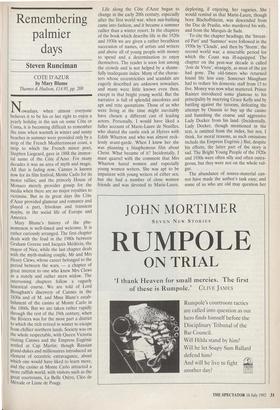Remembering palmier days
Steven Runciman
COTE D'AZUR by Mary Blume Thames & Hudson, £14.95, pp. 208 Nowadays, when almost everyone believes it to be his or her right to enjoy a yearly holiday in the sun on some C6te or Costa, it is becoming difficult to remember the time when warmth in winter and sunny beaches in summer were provided only by a strip of the French Mediterranean coast, a strip to which the French minor poet, Stephen Liegeard, gave in 1888 the immor- tal name of the Cote d'Azur. For many decades it was an area of myth and magic. All that is fading now. Cannes is known now for its film festival, Monte Carlo for its motor rallies; and the princely House of Monaco merely provides gossip for the media when there are no major royalties to victimise. But in its great days the Cote d'Azur provided glamour and romance and played a part, frivolous and transient maybe, in the social life of Europe and America.
Mary Blume's history of the phe- nomenon is well-timed and welcome. It is rather curiously arranged. The first chapter deals with the feud in the 1980s between Graham Greene and Jacques Medecin, the mayor of Nice, while the last chapter deals with the myth-making couple, Mr and Mrs Henry Clews, whose career belonged to the period between the wars, — a chapter of great interest to one who knew Mrs Clews as a stately and rather stern widow. The Intervening chapters follow a vaguely historical course. We are told of Lord Brougham's discovery of Cannes in the 1830s and of M. and Mme Blanc's estab- lishment of the casino at Monte Carlo in the 1860s. But we are taken rather rapidly through the rest of the 19th century, when the Riviera was for the most part a district to which the rich retired in winter to escape from chillier northern lands. Society was on the whole respectable, with Queen Victoria visiting Cannes and the Empress Eugenie settled at Cap Martin: though Russian grand-dukes and millionaires introduced an element of eccentric extravagance, about Which one would have liked to learn more, and the casino at Monte Carlo attracted a more raffish world, with visitors such as the great courtesans, La Belle Otero, Cleo de Merode or Liane de Pougy. Life along the Cote d'Azur began to change in the early 20th century, especially after the first world war, when sun-bathing came into fashion, and it became a summer rather than a winter resort. In the chapters of the book which describe life in the 1920s and 1930s we are given a rather breathless succession of names, of artists and writers and above all of young people with money to spend and a determination to enjoy themselves. The reader is soon lost among the crowds and is not helped by a shame- fully inadequate index. Many of the charac- ters whose eccentricities and scandals are eagerly described are unknown nowadays, and many were little known even then, except in that bright young world. But the narrative is full of splendid anecdotes and apt and trite quotations. Those of us who were living at the time might inevitably have chosen a different cast of leading actors. Personally, I would have liked a fuller account of Marie-Laure de Noailles, who shared the castle rock at Hyeres with Edith Wharton and who was almost reck- lessly avant-garde. When I knew her she was planning a blasphemous film about Christ. What became of it? Incidentally, I must quarrel with the comment that Mrs Wharton hated women and especially young women writers. She was apt to be impatient with young writers of either sex; but she had a number of close women friends and was devoted to Marie-Laure, deploring, if enjoying, her vagaries. She would remind us that Marie-Laure, though born Bischoffsheim, was descended from the Duc de Praslin, who murdered his wife, and from the Marquis de Sade.
To cite the chapter headings, the 'Invent- ed Part' and 'Summer' were followed in the 1930s by 'Clouds', and then by 'Storm', the second world war, a miserable period for which the Coast was ill-equipped. The chapter on the post-war decade is called 'Joie de Vivre', strangely, as most of the joy had gone. The old-timers who returned found life less easy. Somerset Maugham had to reduce his domestic staff from 13 to five. Money was now what mattered. Prince Rainier introduced some glamour to his principality by marrying Grace Kelly and by battling against the tycoons, defeating the attempt by Onassis to buy up the casino and banishing the coarse and aggressive Lady Docker from his land. (Incidentally, Lady Docker, though mentioned in the text, is omitted from the index, but not, I think, for moral reasons, as such omissions include the Empress Eugenie.) But, despite his efforts, the latter part of the story is sad. The Bright Young People of the 1920s and 1930s were often silly and often outra- geous, but they were not on the whole vul- gar.
The abundance of source-material can- not have made the author's task easy; and some of us who are old may question her
judgment on the various characters in her story. But it is a story which she has told with relish, and we must be grateful to her.



















































 Previous page
Previous page